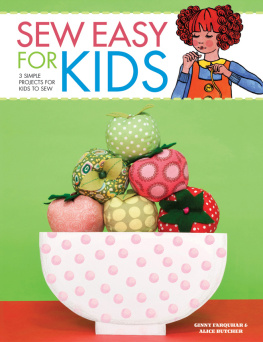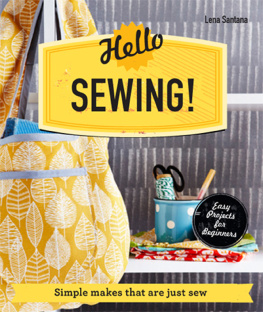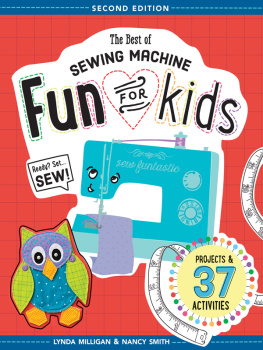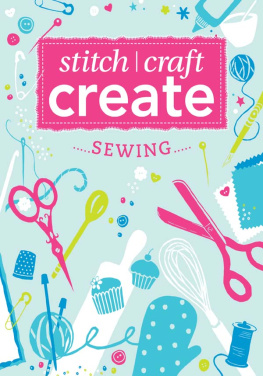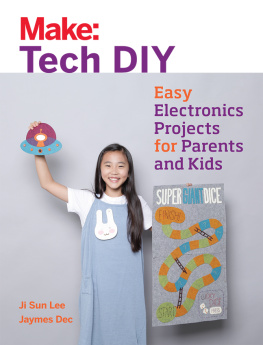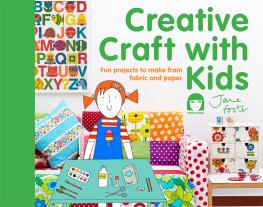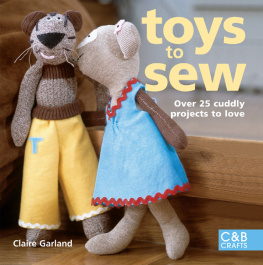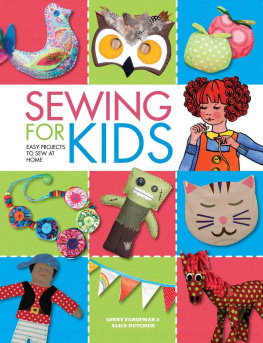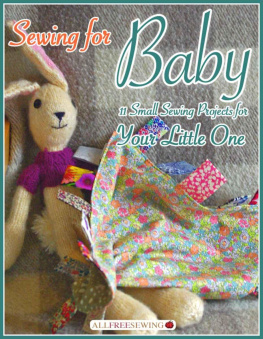Sew Easy for Kids
3 SIMPLE PROJECTS FOR KIDS TO SEW
BY ALICE BUTCHER AND GINNY FARQUHAR
hello and welcome to
Sew Easy for Kids
Let us introduce ourselves: our names are Alice and Ginny and we are sewing teachers. We love making things with fabric and have both been sewing since we were very young.
We really enjoy encouraging young people, just like you, to learn how to sew and have designed this eBook with lots of fun projects for you to make! If you are new to sewing, you will need to work with an adult but once you have learnt some of the basic skills and stitches, you will soon become more independent.
Each project contains a You will learn box, telling you the main skill being taught and a What you will need list, advising you of all the materials you will require. Its a good idea to read through the instructions and look at the pictures with an adult before you begin. We have provided step-by-step drawings and dont forget to look at the finished picture of the project to help you.
Learning to sew is an enjoyable adventure and collecting materials to use is an exciting part of it. Start a fabric scrap box by saving material from old clothes recycling is good for the environment and can save you money. Collect embellishments such as ribbons, buttons and sequins, which can add a lovely finishing touch to your projects.
Most of our projects have been made from cotton or felt and all have been designed to be sewn by hand. Some could also be sewn using a sewing machine (see for tips).
We hope you have lots of fun making the projects!
Alice and Ginny x
handy sewing kit
This basic kit contains many of the essential haberdashery items that you will need for the projects in this ebook.
Scissors
DRESSMAKING SCISSORS (SHEARS)
It is important to have a pair of sharp dressmaking scissors. Make sure you only use them for sewing as they will get blunt; use general-purpose scissors for cutting paper.
EMBROIDERY SCISSORS
A smaller pair of embroidery scissors can be used for trimming fabric and cutting threads.
PINKING SHEARS
Pinking shears have a serrated edge and are used to trim seam edges and prevent fabric from fraying.
Threads
MULTI-PURPOSE POLYESTER THREAD
Suitable for hand and machine sewing, this comes in a huge variety of colours. It can be used with all fabrics and has more stretch than cotton threads so wont snap as easily.
TOPSTITCHING THREAD
Thicker than normal thread, this can be used when you need a stronger thread. It is recommended for most of the hand-sewn projects in this book.
EMBROIDERY SKEINS
Embroidery skeins or threads come in lots of different colours and can be used for both embroidery and hand stitching. Made from six threads twisted together, they can be split to two or three threads for easier sewing.
Hand sewing needles
TAPESTRY NEEDLES
Tapestry needles are quite thick with a large eye and a sharp point, ideal for using with embroidery silks or thick sewing threads.
EMBROIDERY NEEDLES
These come in a variety of sizes. They are slimmer than tapestry needles, allowing for use on finer fabrics but they still have a large eye, making them easy to thread.
SHARPS
These are versatile, medium-length, general sewing needles, built with a sharp point and a round eye.
SEWING MACHINE NEEDLES
Different sizes are suitable for different fabrics, from size 70 for fine fabrics through to size 100 for heavyweight fabrics. Change them regularly as they can get blunt.
Fabric Markers
DRESSMANKERS PENCILS
These mark out fabric clearly and because they are made with chalk, the markings will easily brush away.
VANISHING MARKERS
This can be used like a felt tip to mark or draw outlines on fabric. Because they are light sensitive, they will fade and disappear after a few days.
WATER ERASABLE PEN
This can be used like the vanishing marker however the markings are removed with water.
Sewing accessories
PLASTIC HEADED PINS
These are simple to put in and pull out of fabric and are easily visible for sewing and picking up off the floor!
TAPE MEASURE
It is useful to have one that displays both centimetres and inches and is made from vinyl so it wont stretch.
THIMBLE
A thimble is really useful when hand sewing as it protects your fingers from getting pricked by the needle. They come in different sizes and should be worn on either the index or middle finger.
PINCUSHION AND NEEDLE CASE
These are useful to keep your pins and needles safe. Why not make your own pincushion?
BONDAWEB (DOUBLE-SIDED FUSIBLE WEBBING)
This is a double-sided iron-on fabric adhesive that comes on peel-off paper backing, perfect for crafting and appliqu.
TOY STUFFING
This is essential for stuffing your softies and other toys, such as the Pentagon Patchwork Ball.
OTHER USEFUL ITEMS
It is also handy to have a soft pencil, ruler, rubber, tracing paper, paper and card for making patterns and templates.
Things to know before you start
The following hints and tips will introduce you to the basics and give you the essential sewing know-how that you will need to tackle the projects in this book and beyond.
Fabric
Most of the projects have been made from either cotton or felt. Cotton is a natural fabric that is easy to work with as it doesnt stretch or slip. Felt does not fray and comes in lots of different colours.
The right side of your fabric (R/S) is the side you want to be on the outside of your project. On a printed fabric this is easy to recognize but on a plain fabric you may have to decide which side this is. The wrong side (W/S) is the side you want to be on the inside of your project.
How to cut out fabric
Always press (iron) the fabric first to remove creases, using a pressing cloth over felt to prevent scorching. Pin your pattern/template onto the fabric, using enough pins to keep everything flat. Using dressmaking scissors, cut out your fabric with long strokes on a flat surface, keeping the scissors close to the table or draw around the template, remove pins then cut out.

Templates
All of the templates are full size and can be found within the project pages. To copy them, use a photocopier or place tracing paper (or thin paper) over them and trace around the outline with a pencil. Each template is labelled and advises how many to cut out, e.g. x 2. To cut out two of the same template, fold your piece of fabric in half, pin on the template and cut out carefully.

